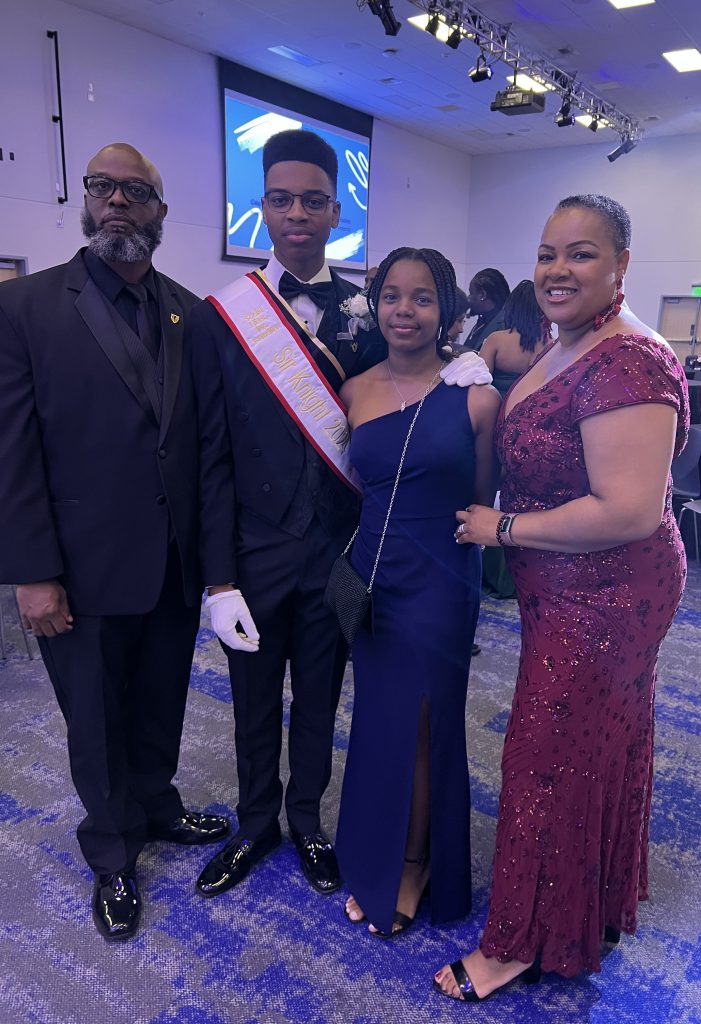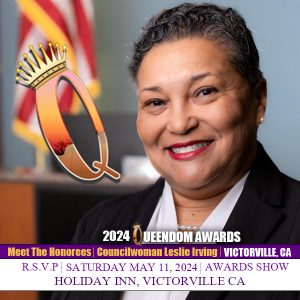SAN BERNARDINO, CA— Seven distinguished young men were presented to society on Saturday, March 30th, 2024, at the beautiful campus of California State University. Sir Knight 2004 Raafi Bell teacher and principle of Hardy Brown College Prep was the Master of Ceremony.
The 57th Annual Beautillion Ball which was no disappointment to a packed house of spectators as each young man was introduced along with their courts. Elegance, excitement, and suspense were thick in the air as the Knights and their courts performed dances with precession for their guests. The Keynote speaker was Dr. Jerrold N. Thompson, Sr., Senior Pastor of San Bernardino Community SDA Church – where he spoke on our theme of “Your Moment of Greatness” and shared his personal examples on the theme.
The Social Lites honored Wallace Allen of Westside Story / Talk Back, Michael Davis, Alton Garrett – Garrett Management Group, Dr. Danielle Osonduagwuike, Tina Darling, Councilman Damon Alexander and SBVC Aeronautics Department of Valley College with service awards for their unselfish act of pouring into our young men through the last 6 months with their various workshops and activities.
In full force our representatives from the federal, state, county and local government were present which included our Congressional Representative Pete Aguilar of the 33rd District, James Ramos California State Assembly representing District 45th office, Assembly member Eloise Gomez-Reyes representing the 50th California Assembly District, Joe Baca Jr. San Bernardino County 5th District, Dr. Gwen Dowdy Rodgers, San Bernardino of the County of School Board and Damon Alexander of the 7th Ward of the City of San Bernardino and Felicia Alexander, San Bernardino City Unified School District Trustee and Social Lite member who presented our Knights with certificates and witnessed the affair.
Our Successful Well Accomplished Gentleman (S.W.A.G.) Award for 2024 was awarded to Edward Brantley, President of the “I Am Gifted Foundation” for providing countless assistance in coaching and providing a stellar example to our young men and Chief Joseph Paulino, Chief of Police for the San Bernardino City Unified School District was awarded the Trail Blazer Award for giving back numerous years to our young men and creating a path while forging ahead for others.
The evening concluded with our crowning of Sir Knight Solomon Moore of Citrus Valley High School. As dubbed Sir Knight, he receiving over $22,500.00 in scholarships and awards for the prestigious title. This included $10,000.00 for the Social Lites, Inc. (SLI) Scholarship, $6,000.00 for the Evan T. Carthen Emerging Leadership Memorial (ETCEL) Award, $3,000 Academic Excellence Award, a $400.00 Mr. Congeniality Award and a $1,000 Travel Voucher including his countless gifts valued at over $1,800.00 for college expenses to allow him to pursue his dream to become a Civil Engineer at Tennessee State University.
Daniel Rivera, Jr., 1st Runner- Up was awarded $8,000.00 along with $3,000 Academic Excellence Award by the (SLI) Scholarship, $1,000.00 for the (ETCEL) Award along with a host of gifts and prizes valued at over $1,800.00.
2nd Runner-Up Syncere Brackett-Lambey was awarded $6,000.00 by the (SLI) Scholarship and $1,000.00 for the (ETCEL) Award along with a host of gifts and prizes valued at over $1,950.00.
Darvion McGee was awarded the Perservance Award by the (SLI) Scholarship of $4,000.00 and $1,000.00 for the (ETCEL) Award along with a host of other gifts and prizes valued at $1,500.00.
Ali Dphrepaulezz was awarded the President Award by the (SLI) Scholarship of $2,000.00 and $1,000.00 Academic Excellence Award and $1,000.00 for the (ETCEL) Award along with a host of other gifts and prizes valued over $1,700.00.
Frank Cox III was awarded the Social Lites Award of $1,500.00, $1,000.00 Academic Excellence Award, $1,000.00 for the (ETCEL) Award and along with a host of other gifts and prizes valued at over $1,100.00.
Destyn Maurice was awarded by the (SLI) Scholarship of $8,000.00 for the Alumni Award and $1,000.00 for the (ETCEL) Award along with other gifts and prizes valued at over $1,100.00.

Each young man received a host of Resolutions and Proclamations by local mayors and dignitaries.
As we conclude our ceremonial event, our work is NOT over. With your help, we are seeking our next African American and brown young men to set on the path toward higher levels through their education. The Social Lites program is a non-profit (501c3) program that created the Beautillion Program. It was started in the Inland Empire out of concern for the future and survival of the young black and brown men in the community in which they live and serve. This program is designed to help young men who are seniors in high school prepare for college through the solicitation of ads, leadership development, accountability, responsibility, etiquette, attire for all occasions, spiritual growth, publics peaking, and community service.
If you know any young men 6 years old to their 1st year in college who aspire to improve with their educational aspirations. Please reach out to us so that we can bring them into the program. If you would like to donate to our cause, we appreciate all contributions. To date, we have we have given out approximately 3.5 million dollars in scholarships to our college bound young men.
For more information, please call President, Sheri Lewis at (909) 320-0799 or publicity chairperson, Marlene Davis at (909) 709-5502
 Westside Story Newspaper – Online The News of The Empire – Sharing the Quest for Excellence
Westside Story Newspaper – Online The News of The Empire – Sharing the Quest for Excellence



